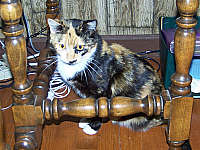
Whew! It's been a busy few weeks, but I'm back. The 4th annual Carolinas Writers Conference is now history. It began Friday evening with Back Porch Stories: ghost stories, Native American stories and just plain "growin' up Southern" stories.
On Saturday, Margaret Maron gave the morning address, with another talk by poet Anthony Abbot after lunch. In between were sessions on any aspect of writing you could wish to attend. I learned a lot about the craft of writing and I think other people did as well.
Then, a complete change of pace on Monday. I am a member of the DAR (Daughters of the American Revolution). We have a small chapter because, frankly, younger women don't seem to have the passion for history that my generation does.
Years ago, in 1928, the original two Anson County chapters got together and placed a bronze plaque on "Execution Rock" to mark the grave of Wadesboro's founder, Col. Thomas Wade. Execution Rock is where the Catawaba Indians beheaded their enemies and was said to weep blood every time it rained.
This rock is 50 yards from the the site of the first courthouse in Anson County. Perhaps Col. Wade wanted to be buried there because, being a local point of interest, the site would always be easily identified.
Some 160 years later, people were beginning to forget the rock's significance
and it was necessary to add a cast bronze plaque to remind them of its historical importance.
Fast forward another 80 years and the site is now farmland, and privately owned. Even if you know about Execution Rock, you can't just go see it; you have to get permission from the owner and then you have to find it.
The rock was largely forgotten until a local historian visited the site and discovered that the numbers for the date of death had been transposed. Instead of 1786, the marker read 1768. He came to the DAR and strongly suggested we fix it. After all, it was our error. Not that any of us were around then.
The members consulted a funeral home -- we figured they would know about plaques and monuments -- and found that to either recast the original bronze plaque or order a new one was prohibitively expensive. An alternative was suggested: add a new marker with the correct date. This, being more in line with our treasury, was the route we took. The new stone says simply, "“Corrected Date of Thomas Wade’s Death is 1786. Placed by Craighead-Wade Chapter DAR 2012.”
Several of us went to the site to see the new marker placed beside Execution Rock. We drove a long, bumpy dirt road, met the man who could open the gate, and followed his pickup along another bumpy, dirt road. Then we walked across the field, weaving our way through brittle cotton stalks with bits and pieces of cotton still clinging to them.
We kept a wary eye out for snakes. The area is said to be a favorite haunt of rattlers. We didn't see any, but I'm willing to bet some were there, wondering why all these humans were disturbing their afternoon sunbath.
We took pictures to commemorate the event and the new, laser-engraved slab was placed in a bed of concrete. Satisfied that history had been served, we retraced our path and went home.
Now, I know that very few people remember where this boulder is. If I didn't have directions written down, I'd never find the place again. Moreover, you need permission from the owner to go there. So the likelihood of anyone seeing the new plaque is as remote as the site itself.
Why did we do it? Because we wanted the wording to be accurate. Too much of our history is being distorted, lost or ignored. Both markers are constructed to last for years, if not centuries. That field may not always be farmland. In the event that years down the road the marker is rediscovered, we wanted the finders to know that long ago, there was a group of women -- and one determined man -- who wanted our history be recorded accurately.
In stone.
 In addition to being a presenter, I also had the opportunity to attend a couple of sessions. I especially enjoyed Marjorie Hudson, author of "Accidental Birds of the Carolinas." After reading her book, the committee unanimously decided to ask her to talk about using the five senses in writing. She writes wonderfully descriptive stories and her workshop made me determined to describe more accurately what my characters are tasting, smelling and touching along with seeing and hearing.
In addition to being a presenter, I also had the opportunity to attend a couple of sessions. I especially enjoyed Marjorie Hudson, author of "Accidental Birds of the Carolinas." After reading her book, the committee unanimously decided to ask her to talk about using the five senses in writing. She writes wonderfully descriptive stories and her workshop made me determined to describe more accurately what my characters are tasting, smelling and touching along with seeing and hearing.